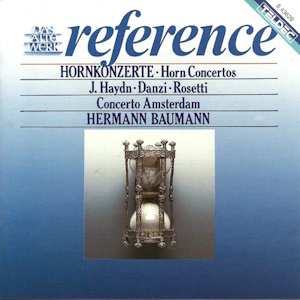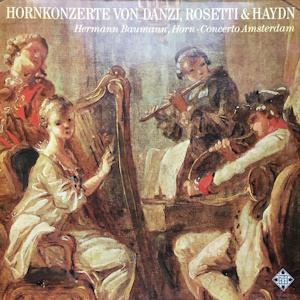 |
| 1 CD -
8.43629 ZS - (c) 1987 |
 |
1 LP -
SAT 22 516 - (p) 1969
|
|
HORNKONZERTE
|
|
|
|
|
|
|
|
|
|
| Joseph
HAYDN (1732-1809) |
Konzert
Nr. 1 D-dur für Horn und Orchester
- HV VII d, Nr. 1 (2 Oboen u.
Streicher) |
|
17' 19" |
|
|
|
- Allegro |
6' 36" |
|
1 |
A1 |
|
- Adagio |
6' 59" |
|
2 |
A2 |
|
- Allegro |
3' 50" |
|
3 |
A3 |
| Franz DANZI
(1763-1826) |
Konzert
für Horn und Orchester E-dur -
(Corno
principale in Mi; Flauto
I/II; Corno I/II in Mi;
Violino I/II; Viola;
Violoncello e Contrabasso) |
|
15' 30" |
|
|
|
-
Allegro
|
8' 24" |
|
4 |
A4
|
|
- Romance |
3' 51" |
|
5 |
B1
|
|
- Rondeau: Allegro |
3' 22" |
|
6 |
B2
|
| Antoni ROSETTI
(1750-1792) |
Konzert
d.moll für Horn und Orchester
- (2 Oboen, Hörner u. Streicher) |
|
18' 38" |
|
|
|
- Allegro molto
|
9' 38" |
|
7 |
B3
|
|
-
Romanze
|
3' 55" |
|
8 |
B4 |
|
-
Rondo |
5' 12" |
|
9 |
B5 |
|
|
|
|
|
Hermann
Baumann, Horn
|
| CONCERTO
AMSTERDAM |
Jaap SCHRÖDER,
Konzertmeister
|
|
|
|
|
Luogo
e data di registrazione |
|
-
|
|
|
Registrazione:
live / studio |
|
studio |
|
|
Producer |
|
-
|
|
|
Prima Edizione
LP |
|
Telefunken
- SAT 22 516 - (1 LP) - durata 51'
27" - (p) 1969 - Analogico
|
|
|
Edizione
"Reference" CD
|
|
Tedec
- 8.43629 ZS - (1 CD) - LC 3706 -
durata 51' 27" - (c) 1987 - AAD |
|
|
Cover |
|
Foto
mit freundlicher Genehmigung des
Museums fèr Kunst und Gewerbe,
Hamburg
|
|
|
Note |
|
-
|
|
|
|
|
These
three horn concertos are
representative of a
music performed in a
festive, 18th century
Rococo setting, in the
palaces of counts,
barons and princes who,
themselves, were often
accomplished musicians
and played with the
orchestra. This seldom
comprised more than ten
players and was
frequently joined by a
concertante quartet or
soloist, The sort of
music produced at such
soirées was
light-hearted and
careiree. Within the
clearly defined forms of
the different movements
the melody and harmony
move with agile ease.
The spirited Allegro
always starts off with
an ordrestral
introduction. Following
this, the soloist
predominant, the
thematic material is
played and worked out in
a development section. A
recapitulation with a
cadenza by the soloist
leads into the finale.
The adagio mood oi a
romanza allows of
greater emotional depth
in the second movement.
The ingenious, virtuose
alternation of main
subject and episodes
lends gaiety to the
third and concluding
movement, a rondo.
The horn has a long
history as a solo
instrument. From time
immemorial its powerful
carrying tone, varying
between a dull grumble
and a sharp blast, has
served in sacred and
mystic rites, in the
hunt and in war. The
first ‘natural’ horn
possessed only few
notes. It was not until
the horn was brought out
of its occult world of
calls and signals to he
used with other
instruments for the
purpose of making music
that. to extend its
range, the mechanism had
to be improved upon by
means of valves and
keys. The horn became
‘domesticated’ and since
the 18th century has
appeared in the
orchestra as a solo
instrument. It has since
been perfected to
include the whole
chromatic scale and in
the horn concertos
presented in this
recording it is a
pleasure to listen the
sound quality and ease
of tone production.
The Horn Concerto No.
i in D major by Haydn
was composed in 1762. It
was in that year that an
outstanding player of
the hunting horn joined
the Esterhazy court
orchestra of which Haydn
was the Kapellmeister.
Haydn composed four horn
concertos tor him, and
surprised the court with
them. Two of them are no
longer extant. In No. 1
the horn is not called
upon to perform any
feats of particular
brilliance, but has a
considerable say in each
movement. A press notice
of the year 1792
describes how the
essence of Haydn's music
finds expression in this
work too: "His work has
beauty, order, unity and
a line and noble
simplicity that the
listener experiences
even before he becomes
aware of it."
Franz Danzi, the
son of an Italian
musician, was born in
Mannheim, where at this
time the local orchestra
under Stamitz was laying
the foundations of the
renowned ‘Mannheim
School‘. This influence
naturally made itself
felt in Danzi'a work and
finds expression in the
E major Horn Concerto.
The congenial melody of
the horn part receives
sparse orchestral
accompaniment. In fact
it is not until the
interludes that the
orchestra makes any
musical statement of its
own or takes up the solo
material. In a cadenza
at the close of the
first movement the horn
contributes some
reflective nuances and
is quickly submerged
again under the
orchestra. A section in
a minor kay gives the
second movement, a
romanza, its elegiac
nature. Then follows a
highspirited rondo in
strict form: main
subject and episode
linked by a cadanza
appear in two three-part
sections with a minor
passage in the middle.
Danzi lived in Munich,
Stuttgart and Karlsruhe
working as a musician
and composer at the
courts of the lord
spiritual and temporal
of the time. He achieved
historical significance
with his operas and
Singspiele which,
overtaking other
contemporary works,
anticipated Carl Maria
von Weber and the
Romantic movement.
Franz Anton Rößler, a
Bohemian, who
called himself Antoni
Rosetti, was a
popular composer in
Rococo times. He is
acclaimed as a leading
syrnphonist and, like
Haydn and Mozart,
followed the principle
of the essential unity
of the different
movements in a symphonic
composition, thus making
his contribution to a
classical form that was
to become standard. His
music has a primitive
strength, a certain
naive simplicity about
it and a recurring
passionate, dramatic
impulse. In Gerber‘s
Musical-Biographical
Dictionary of 1792 we
also find: "It is
undeniable that a
pleasantly-caressing,
sweetly dallying tone
pervades his works, and
one is particulariy
struck by the extreme
beauty of his
compositions for wind
instruments, which he
invariably employs in
the orchestra with a
masterly hand." His
reputation secured for
him the post of
Kapellmeister at the
court of the Prlnce of
Ludwigslust in
Mecklenburg "where ha
had the honour and
pleasure of finding and
conducting one og
Germany's finest
orchestras, rich in men
of great merit."
Otto
v. Irmer
|
|